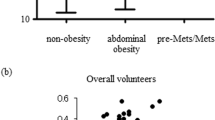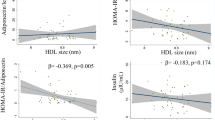Abstract
Patients with metabolic syndrome (MetS) usually have low high density lipoprotein cholesterol (HDL-C) levels. We determined the HDL distribution profile as well as the HDL-related lipoprotein associated phospholipase A2 (HDL-LpPLA2) and paraoxonase-1 (PON1) activities in subjects with MetS (n = 189) but otherwise healthy. Age and sex-matched individuals (n = 166) without MetS served as controls. The lower HDL-C concentration in MetS patients was due to a reduction in both large and small HDL subclasses (P < 0.001 and P < 0.05, respectively). As the number of MetS components increased, the HDL phenotype comprised of a greater percentage of small HDL-3 and less large HDL-2 subclasses, resulting in a decreased HDL-2/HDL-3 ratio (P < 0.001 for all trends). Multivariate analysis revealed that HDL-2 levels and the HDL-2/HDL-3 ratio significantly and independently correlated with HDL-C (positively) and TG (negatively) levels. HDL-3 concentration significantly and independently positively correlated with HDL-C and TG levels. HDL-LpPLA2 activity was decreased in MetS patients (P < 0.01), a phenomenon that may contribute to the defective antiatherogenic activity of HDL in MetS. PON1 activity did not differ between groups. We conclude that MetS, in addition to the decrease in HDL-C concentration, is associated with alterations in the HDL phenotype, which is comprised of a greater percentage of small HDL subclasses. Furthermore, HDL-LpPLA2 activity is decreased in MetS patients.


Similar content being viewed by others
References
Eckel RH, Grundy SM, Zimmet PZ (2005) The metabolic syndrome. Lancet 365:1415–1428
Daskalopoulou SS, Mikhailidis DP, Elisaf M (2004) Prevention and treatment of the metabolic syndrome. Angiology 55:589–612
Lakka HM, Laaksonen DE, Lakka TA, Niskanen LK et al (2002) The metabolic syndrome and total and cardiovascular disease mortality in middle-aged men. JAMA 288:2709–2716
Gazi I, Tsimihodimos V, Filippatos T, Bairaktari E, Tselepis AD, Elisaf M (2006) Concentration and relative distribution of low-density lipoprotein subfractions in patients with metabolic syndrome defined according to the National Cholesterol Education Program criteria. Metabolism 55:885–891
Chapman MJ, Assmann G, Fruchart JC, Shepherd J, Sirtori C (2004) Raising high-density lipoprotein cholesterol with reduction of cardiovascular risk: the role of nicotinic acid––a position paper developed by the European Consensus Panel on HDL-C. Curr Med Res Opin 20:1253–1268
Kontush A, Chapman MJ (2006) Antiatherogenic small, dense HDL––guardian angel of the arterial wall? Nat Clin Pract Cardiovasc Med 3:144–153
Asztalos BF, Cupples LA, Demissie S, Horvath KV et al (2004) High-density lipoprotein subpopulation profile and coronary heart disease prevalence in male participants of the Framingham Offspring Study. Arterioscler Thromb Vasc Biol 24:2181–2187
Salonen JT, Salonen R, Seppanen K, Rauramaa R, Tuomilehto J (1991) HDL, HDL2, and HDL3 subfractions, and the risk of acute myocardial infarction. A prospective population study in eastern Finnish men. Circulation 84:129–139
Link JJ, Rohatgi A, de Lemos JA (2007) HDL cholesterol: physiology, pathophysiology, and management. Curr Probl Cardiol 32:268–314
Florentin M, Liberopoulos EN, Wierzbicki AS, Mikhailidis DP (2008) Multiple actions of high-density lipoprotein. Curr Opin Cardiol 23:370–378
Tselepis AD, Chapman JM (2002) Inflammation, bioactive lipids and atherosclerosis: potential roles of a lipoprotein-associated phospholipase A2, platelet activating factor-acetylhydrolase. Atheroscler Suppl 3:57–68
James RW (2006) A long and winding road: defining the biological role and clinical importance of paraoxonases. Clin Chem Lab Med 44:1052–1059
Grundy SM, Cleeman JI, Merz CN, Brewer HB Jr et al (2004) Implications of recent clinical trials for the National Cholesterol Education Program Adult Treatment Panel III guidelines. J Am Coll Cardiol 44:720–732
Bairaktari ET, Seferiadis KI, Elisaf MS (2005) Evaluation of methods for the measurement of low-density lipoprotein cholesterol. J Cardiovasc Pharmacol Ther 10:45–54
Saougos VG, Tambaki AP, Kalogirou M, Kostapanos M et al (2007) Differential effect of hypolipidemic drugs on lipoprotein-associated phospholipase A2. Arterioscler Thromb Vasc Biol 27:2236–2243
Filippatos TD, Liberopoulos EN, Kostapanos M, Gazi IF et al (2008) The effects of orlistat and fenofibrate, alone or in combination, on high-density lipoprotein subfractions and pre-beta1-HDL levels in obese patients with metabolic syndrome. Diabetes Obes Metab 10:476–483
Gazi I, Lourida ES, Filippatos T, Tsimihodimos V, Elisaf M, Tselepis AD (2005) Lipoprotein-associated phospholipase A2 activity is a marker of small, dense LDL particles in human plasma. Clin Chem 51:2264–2273
Filippatos TD, Gazi IF, Liberopoulos EN, Athyros VG et al (2007) The effect of orlistat and fenofibrate, alone or in combination, on small dense LDL and lipoprotein-associated phospholipase A2 in obese patients with metabolic syndrome. Atherosclerosis 193:428–437
Tselepis AD, Dentan C, Karabina SA, Chapman MJ, Ninio E (1995) PAF-degrading acetylhydrolase is preferentially associated with dense LDL and VHDL-1 in human plasma. Catalytic characteristics and relation to the monocyte-derived enzyme. Arterioscler Thromb Vasc Biol 15:1764–1773
Tsimihodimos V, Karabina SA, Tambaki AP, Bairaktari E et al (2002) Atorvastatin preferentially reduces LDL-associated platelet-activating factor acetylhydrolase activity in dyslipidemias of type IIA and type IIB. Arterioscler Thromb Vasc Biol 22:306–311
von Eckardstein A, Nofer JR, Assmann G (2001) High density lipoproteins and arteriosclerosis. Role of cholesterol efflux and reverse cholesterol transport. Arterioscler Thromb Vasc Biol 21:13–27
Deeb SS, Zambon A, Carr MC, Ayyobi AF, Brunzell JD (2003) Hepatic lipase and dyslipidemia: interactions among genetic variants, obesity, gender, and diet. J Lipid Res 44:1279–1286
Kathiresan S, Otvos JD, Sullivan LM, Keyes MJ et al (2006) Increased small low-density lipoprotein particle number: a prominent feature of the metabolic syndrome in the Framingham Heart Study. Circulation 113:20–29
de Souza JA, Vindis C, Hansel B, Negre-Salvayre A et al (2008) Metabolic syndrome features small, apolipoprotein A-I-poor, triglyceride-rich HDL3 particles with defective anti-apoptotic activity. Atherosclerosis 197:84–94
Ji J, Watts GF, Johnson AG, Chan DC et al (2006) High-density lipoprotein (HDL) transport in the metabolic syndrome: application of a new model for HDL particle kinetics. J Clin Endocrinol Metab 91:973–979
Asztalos BF, Collins D, Cupples LA, Demissie S et al (2005) Value of high-density lipoprotein (HDL) subpopulations in predicting recurrent cardiovascular events in the veterans affairs HDL intervention trial. Arterioscler Thromb Vasc Biol 25:2185–2191
Asztalos BF, Batista M, Horvath KV, Cox CE et al (2003) Change in alpha1 HDL concentration predicts progression in coronary artery stenosis. Arterioscler Thromb Vasc Biol 23:847–852
Otvos JD, Collins D, Freedman DS, Shalaurova I et al (2006) Low-density lipoprotein and high-density lipoprotein particle subclasses predict coronary events and are favorably changed by gemfibrozil therapy in the Veterans Affairs High-Density Lipoprotein Intervention Trial. Circulation 113:1556–1563
Athyros VG, Kakafika AI, Karagiannis A, Mikhailidis DP (2008) Do we need to consider inflammatory markers when we treat atherosclerotic disease? Atherosclerosis 200:1–12
Elisaf M, Tselepis AD (2003) Effect of hypolipidemic drugs on lipoprotein-associated platelet activating factor acetylhydrolase. Implication for atherosclerosis. Biochem Pharmacol 66:2069–2073
Hansel B, Kontush A, Bonnefont-Rousselot D, Bruckert E, Chapman MJ (2006) Alterations in lipoprotein defence against oxidative stress in metabolic syndrome. Curr Atheroscler Rep 8:501–509
Hansel B, Giral P, Nobecourt E, Chantepie S et al (2004) Metabolic syndrome is associated with elevated oxidative stress and dysfunctional dense high-density lipoprotein particles displaying impaired antioxidative activity. J Clin Endocrinol Metab 89:4963–4971
Rizos E, Tambaki AP, Gazi I, Tselepis AD, Elisaf M (2005) Lipoprotein-associated PAF-acetylhydrolase activity in subjects with the metabolic syndrome. Prostaglandins Leukot Essent Fatty Acids 72:203–209
Mackness MI, Mackness B, Durrington PN, Connelly PW, Hegele RA (1996) Paraoxonase: biochemistry, genetics and relationship to plasma lipoproteins. Curr Opin Lipidol 7:69–76
Mackness MI, Durrington PN (1995) HDL, its enzymes and its potential to influence lipid peroxidation. Atherosclerosis 115:243–253
Mackness MI, Mackness B, Durrington PN (2002) Paraoxonase and coronary heart disease. Atheroscler Suppl 3:49–55
Mackness MI, Arrol S, Abbott C, Durrington PN (1993) Protection of low-density lipoprotein against oxidative modification by high-density lipoprotein associated paraoxonase. Atherosclerosis 104:129–135
Garin MC, Kalix B, Morabia A, James RW (2005) Small, dense lipoprotein particles and reduced paraoxonase-1 in patients with the metabolic syndrome. J Clin Endocrinol Metab 90:2264–2269
Moldoveanu E, Tanaseanu C, Tanaseanu S, Kosaka T et al (2006) Plasma markers of endothelial dysfunction in type 2 diabetics. Eur J Intern Med 17:38–42
Mackness MI, Harty D, Bhatnagar D, Winocour PH et al (1991) Serum paraoxonase activity in familial hypercholesterolaemia and insulin-dependent diabetes mellitus. Atherosclerosis 86:193–199
Mackness B, Durrington PN, Abuashia B, Boulton AJ, Mackness MI (2000) Low paraoxonase activity in type II diabetes mellitus complicated by retinopathy. Clin Sci (Lond) 98:355–363
Brites FD, Verona J, Schreier LE, Fruchart JC, Castro GR, Wikinski RL (2004) Paraoxonase 1 and platelet-activating factor acetylhydrolase activities in patients with low HDL-cholesterol levels with or without primary hypertriglyceridemia. Arch Med Res 35:235–240
Nobecourt E, Jacqueminet S, Hansel B, Chantepie S et al (2005) Defective antioxidative activity of small dense HDL3 particles in type 2 diabetes: relationship to elevated oxidative stress and hyperglycaemia. Diabetologia 48:529–538
Kalmar T, Seres I, Balogh Z, Kaplar M, Winkler G, Paragh G (2005) Correlation between the activities of lipoprotein lipase and paraoxonase in type 2 diabetes mellitus. Diabetes Metab 31:574–580
Hedrick CC, Thorpe SR, Fu MX, Harper CM et al (2000) Glycation impairs high-density lipoprotein function. Diabetologia 43:312–320
Rysz J, Blaszczak R, Banach M, Kedziora-Kornatowska K et al (2007) Evaluation of selected parameters of the antioxidative system in patients with type 2 diabetes in different periods of metabolic compensation. Arch Immunol Ther Exp (Warsz) 55:335–340
Persson M, Hedblad B, Nelson JJ, Berglund G (2007) Elevated Lp-PLA2 levels add prognostic information to the metabolic syndrome on incidence of cardiovascular events among middle-aged nondiabetic subjects. Arterioscler Thromb Vasc Biol 27:1411–1416
Saltevo J, Vanhala M, Kautiainen H, Kumpusalo E, Laakso M (2007) Association of C-reactive protein, interleukin-1 receptor antagonist and adiponectin with the metabolic syndrome. Mediators Inflamm. 2007:93573
Milionis HJ, Rizos E, Goudevenos J, Seferiadis K, Mikhailidis DP, Elisaf MS (2005) Components of the metabolic syndrome and risk for first-ever acute ischemic non-embolic stroke in elderly subjects. Stroke 36:1372–1376
Gazi IF, Tsimihodimos V, Tselepis AD, Elisaf M, Mikhailidis DP (2007) Clinical importance and therapeutic modulation of small dense low-density lipoprotein particles. Expert Opin Biol Ther 7:53–72
Filippatos T, Tsimihodimos V, Kostapanos M, Kostara C et al (2008) Small dense LDL cholesterol and apolipoproteins C-II and C-III in non-diabetic obese subjects with metabolic syndrome. Arch Med Sci 4:263–269
Conflict of interest statement
The present study was carried out independently; no pharmaceutical company supported it financially. Some of the authors have given talks, attended conferences and participated in advisory boards and other trials sponsored by various pharmaceutical companies.
Author information
Authors and Affiliations
Corresponding author
About this article
Cite this article
Lagos, K.G., Filippatos, T.D., Tsimihodimos, V. et al. Alterations in the High Density Lipoprotein Phenotype and HDL-Associated Enzymes in Subjects with Metabolic Syndrome. Lipids 44, 9–16 (2009). https://doi.org/10.1007/s11745-008-3251-9
Received:
Accepted:
Published:
Issue Date:
DOI: https://doi.org/10.1007/s11745-008-3251-9




